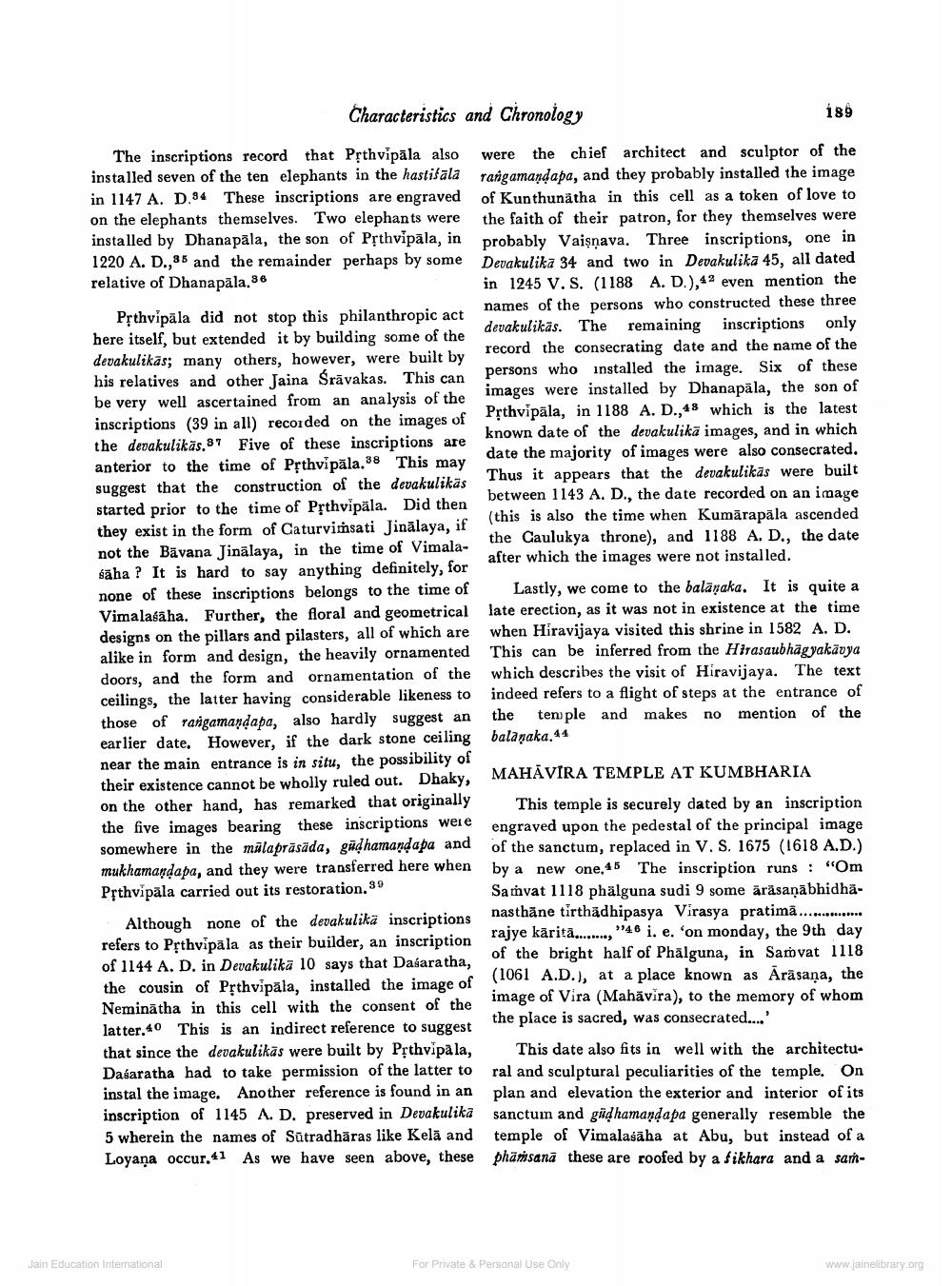________________
Characteristics and Chronology
189
The inscriptions record that Pșthvipāla also were the chief architect and sculptor of the installed seven of the ten elephants in the hastifāla rangamandapa, and they probably installed the image in 1147 A. D.84 These inscriptions are engraved of Kunthunatha in this cell as a token of love to on the elephants themselves. Two elephants were the faith of their patron, for they themselves were installed by Dhanapāla, the son of Pșthvipāla, in probably Vaişņava. Three inscriptions, one in 1220 A. D. 35 and the remainder perhaps by some Devakulika 34 and two in Devakulika 45, all dated relative of Dhanapāla.36
in 1245 V.S. (1188 A.D.),42 even mention the Pșthvipāla did not stop this philanthropic act
names of the persons who constructed these three
devakulikās. The remaining inscriptions only here itself, but extended it by building some of the devakulikās; many others, however, were built by
record the consecrating date and the name of the
persons who installed the image. Six of these his relatives and other Jaina Srävakas. This can
images were installed by Dhanapala, the son of be very well ascertained from an analysis of the
Pșthvipala, in 1188 A. D.,48 which is the latest inscriptions (39 in all) recorded on the images of the devakulikās.87 Five of these inscriptions are
known date of the devakulikā images, and in which
date the majority of images were also consecrated. anterior to the time of Ppthvipala,38 This may
Thus it appears that the devakulikās were built suggest that the construction of the devakulikäs
between 1143 A. D., the date recorded on an image started prior to the time of Pythvipäla. Did then
(this is also the time when Kumārapäla ascended they exist in the form of Caturvimsati Jinālaya, if
the Caulukya throne), and 1188 A. D., the date not the Bāvana Jinālaya, in the time of Vimala
after which the images were not installed. säha ? It is hard to say anything definitely, for none of these inscriptions belongs to the time of Lastly, we come to the balāņaka. It is quite a Vimalasäha. Further, the floral and geometrical late erection, as it was not in existence at the time designs on the pillars and pilasters, all of which are when Hiravijaya visited this shrine in 1582 A. D. alike in form and design, the heavily ornamented This can be inferred from the Hirasaubhagyakävya doors, and the form and ornamentation of the which describes the visit of Hiravijaya. The text ceilings, the latter having considerable likeness to indeed refers to a flight of steps at the entrance of those of tangamandapa, also hardly suggest an the temple and makes no mention of the earlier date. However, if the dark stone ceiling balanaka. 44 near the main entrance is in situ, the possibility of
MAHĀVIRA TEMPLE AT KUMBHARIA their existence cannot be wholly ruled out. Dhaky, on the other hand, has remarked that originally This temple is securely dated by an inscription the five images bearing these inscriptions were engraved upon the pedestal of the principal image somewhere in the malaprāsāda, güdhamandapa and of the sanctum, replaced in V. S. 1675 (1618 A.D.) mukhamandapa, and they were transferred here when by a new one.45 The inscription runs: "Om Prthvipala carried out its restoration. 30
Samvat 1118 phälguna sudi 9 some ärāsaņābhidhaAlthough none of the devakulika inscriptions
nasthāne tirthadhipasya Virasya pratima..............
rajye kāritā........, 46 i. e. 'on monday, the 9th day refers to Pșthvipāla as their builder, an inscription
of the bright half of Phālguna, in Samvat 1118 of 1144 A. D. in Devakulika 10 says that Dasaratha,
(1061 A.D.), at a place known as Ārāsaņa, the the cousin of Pșthvipāla, installed the image of Neminātha in this cell with the consent of the
image of Vira (Mahāvira), to the memory of whom latter.40 This is an indirect reference to suggest
the place is sacred, was consecrated.... that since the devakulikās were built by Ppthvipa la, This date also fits in well with the architectuDasaratha had to take permission of the latter to ral and sculptural peculiarities of the temple. On instal the image. Another reference is found in an plan and elevation the exterior and interior of its inscription of 1145 A. D. preserved in Devakulika sanctum and güdhamandapa generally resemble the 5 wherein the names of Sūtradhäras like Kelā and temple of Vimalasāha at Abu, but instead of a Loyaņa occur.41 As we have seen above, these phänsana these are roofed by a fikhara and a san
Jain Education International
For Private & Personal Use Only
www.ainelibrary.org




